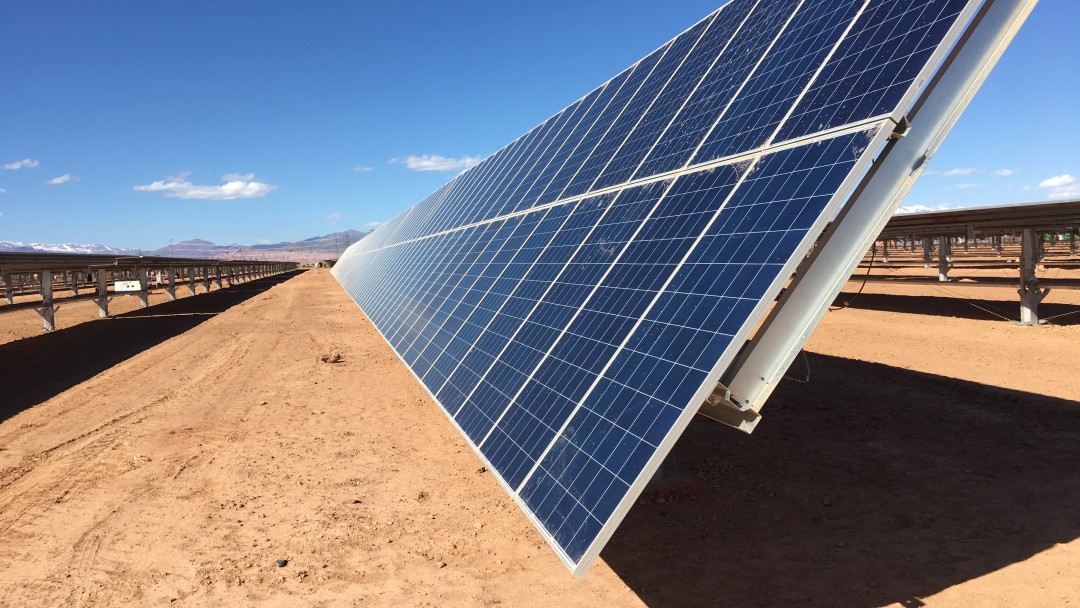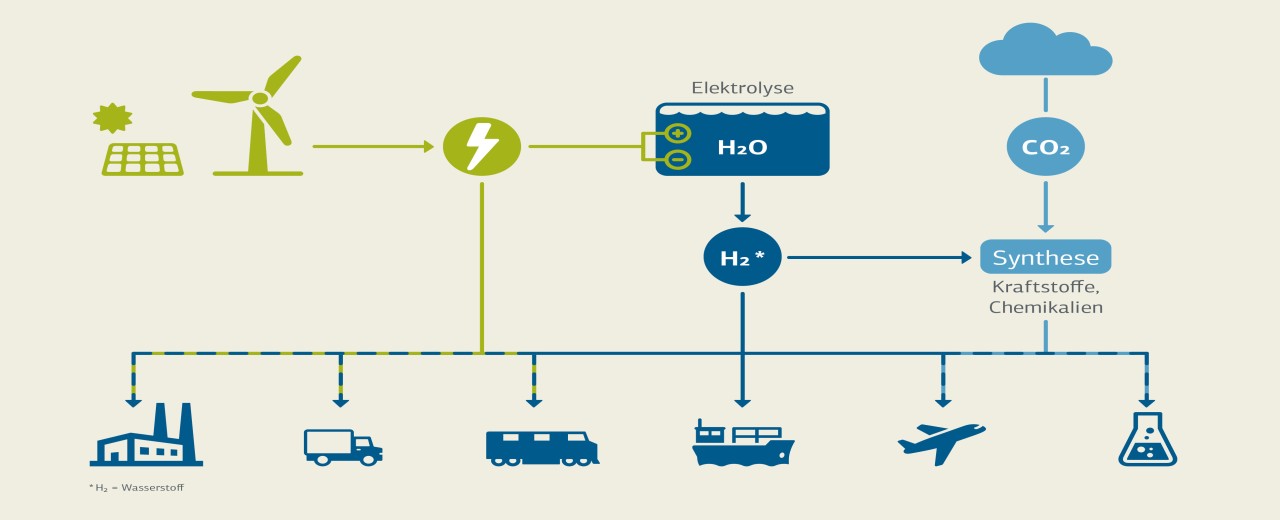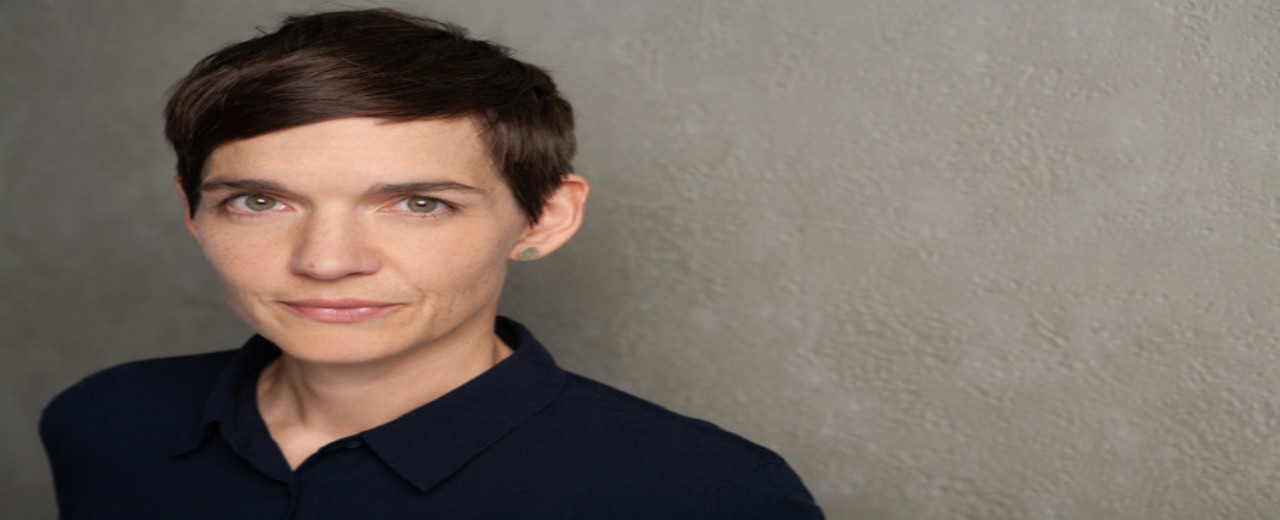
Marie Plaisir from the Fraunhofer Institute Kassel (IEE), Judith Kammerer from the German Federal Ministry for Economic Cooperation and Development (BMZ) and Wesly Urena Vargas and Florian Ziegler, both from KfW Entwicklungsbank, in an interview. They are part of a cross-institutional team working on the production and use of green hydrogen. Background: Germany has committed to becoming climate neutral by 2050. To achieve this, energy efficiency must be improved on the one hand and fossil fuels must be replaced by renewable energies on the other. Power-to-X - green hydrogen - serves as a catalyst for the increased expansion of renewables. KfW Entwicklungsbank has concluded hydrogen alliances with Morocco and Tunisia on behalf of the German Federal Government, and studies are currently being conducted on the construction of a reference plant for the industrial production of green hydrogen in Morocco.
MP: Grey hydrogen is produced from fossil fuels: Mainly natural gas is used in the production process and converted into hydrogen and CO2 under heat. This so-called steam reforming is the basic technology. The CO2 is then released unused into the atmosphere, thus increasing the global greenhouse effect. The production of one tonne of hydrogen generates slightly more than 10 tonnes of CO2.
According to the International Energy Agency (IEA), approximately 70 million tonnes of hydrogen were produced worldwide in 2019 - an enormous amount. This emitted 830 million tonnes of CO2e, which is roughly equivalent to Germany's total greenhouse gas emissions in 2019.
To produce green hydrogen, electrical energy from renewable sources is used, usually photovoltaic or wind energy. Currently, electrolytically produced hydrogen accounts for only about 4 percent of global hydrogen production. About the technology: through electrolysis, water is broken down into hydrogen (H2) and oxygen (O2) with the help of electric current. In the "electrolyser" there are two electrodes to which voltage is applied, with a so-called electrolyte, a liquid or membrane, in between. Oxygen is produced at the anode and the much sought-after hydrogen - green hydrogen - at the cathode.

MP: Electrolysis itself is not new at all, it has been practised for many decades and water electrolysis has also been around for a long time; in Aswan / Egypt, for example, there was a large electrolyser at a hydroelectric power plant. What is NEW is on the one hand the scaling - the intention is now to build larger plants, and on the other hand the combination with renewable energies. This requires technical adjustments because renewable energies generate electricity in a fluctuating - not constant - manner. At the IEE, we have been working very intensively for many years on the necessary technical system solutions for the cost-efficient and sustainable production of green hydrogen from renewable energies.

WUV: The spectrum is very broad: it ranges from fuel for trucks to the production of ammonia for fertilizers or cement production. An example from Germany: Salzgitter AG, the country's second-largest steelworks, wants to produce steel with green hydrogen instead of coal in the future. Technically, this is already possible. 95 percent of the previous CO₂ emissions could be avoided in this way. From as early as 2025, low-CO2 steel is to be produced in Salzgitter on the basis of green hydrogen - with the help of wind energy.

FZ: Not only Germany, but also the EU has committed to becoming climate neutral by 2050. To achieve this, energy efficiency must be improved on the one hand and fossil fuels must be replaced by renewable energies on the other.
We are already doing this to some extent - but renewables cannot be used directly everywhere. This is possible in electricity production, for example, but not in heavy industry, aviation, marine industries and feedstock, where very high energy densities are needed. Green hydrogen is needed there - OR its synthetic derivatives such as green methane, methanol or ammonia. Germany will have to import a large part of it. And it is precisely from this that opportunities for economic cooperation arise. The countries of North Africa, especially Morocco, Tunisia and Algeria, have ideal conditions; there are excellent locations for solar and wind power. And they are well connected to the European markets.
For countries like Morocco, the site conditions yield a double dividend: On the one hand, they have the chance to build a promising export economy. And: Morocco is more than 90% dependent on the import of fossil energy. This puts a strain on the current account balance. By developing a hydrogen industry, this dependence can be reduced, and local value can be created.
FZ: Hydrogen is considered an important and forward-looking element of energy supply, not least because of its versatility. The value of green hydrogen depends on where it is used. It therefore makes sense to first develop those applications where hydrogen is already used and where a relatively large amount of CO2 can be avoided. After all, that is the goal that drives us. While applications are already emerging in the primary industry with the appropriate support, marine industries and aviation, for example, will only come into focus in the medium term. One thing is certain: although considerable cost reductions are expected, green hydrogen and its derivatives will still be more expensive than their fossil alternatives for many years to come. This is comparable to the situation with photovoltaics 20 years ago.
Clear regulatory framework conditions and economic incentives are therefore crucial for the market ramp-up. The German government and the EU are currently working on a whole range of instruments. These range from subsidies for market introduction to minimum quota for sustainable fuels to CO2 pricing. Climate projects with innovative technologies like this are financed by KfW on behalf of BMZ in developing and emerging countries with a mixture of grants and concessional loans with long maturities. This can mobilize private capital, which is necessary to achieve broad market penetration.

JK: BMZ's commitment to green hydrogen is based on the National Hydrogen Strategy, which the Federal Government adopted in June 2020: In addition to the expansion of renewable energies and energy efficiency, the energy transition is to be given a third pillar in the form of green hydrogen. Green hydrogen is to be promoted not only in Germany, but also within the framework of international partnerships. This should help to achieve the climate goals that were agreed upon in the Paris Climate Agreement. Especially in areas where renewable energies cannot be used directly, decarbonization is to be achieved in this way.
This task is being tackled across ministries. BMZ focuses on development cooperation with partner countries where the conditions for green hydrogen production are good. The aim is to develop the potential green hydrogen has for the economies of partner countries. And to do so in a socio-economic as well as ecologically justifiable and compatible way - national value creation is a keyword here -. In addition, the export of green hydrogen and power-to-X downstream products can help to meet the needs of the German and European markets.
Morocco was the first country with which BMZ took up the future topic of energy transition. Geographical and climatic factors play a role here, but of course also the many years of good cooperation in the energy sector with very competent and reliable partners. Innovative projects have been successfully implemented in the country for about twenty years - these are the best conditions for the joint development of a power-to-X sector. BMZ has therefore established the first hydrogen alliance with Morocco and provided almost EUR 90 million in grant funding for the P-t-X sector for 2020, with further investments to follow in the coming years. In this context, the ambitious "Green Hydrogen Reference Project" is being implemented.
JK: Morocco has a stable energy supply and ambitious goals for the expansion of renewable energies. However, this does not apply to all developing countries. In principle, it has to be ensured that the quantities that are to be exported are generated in addition to energy production in the respective partner countries. This means that it is not at the expense of the often deficiently renewable energy supply in the developing countries.
JK: The climatic conditions are similarly good as in Morocco and the country is very interested in positioning itself in the climate / green hydrogen sector. We signed a hydrogen alliance in mid-December 2020 for the development of a power-to-X sector - a first step. We are providing 31 million euros in grant funds for initial projects, some of which are also being implemented with KfW Development Bank and GIZ. The first step is to create the framework conditions before large scale production facilities can be built there in the future.
Basically, there is no time to lose on the issue of climate change - we must understand where the countries stand, and support them in the transition accordingly?

The interview was conducted by Susanne Schröder
Further information
How Salzgitter AG intends to convert its steelworks to green hydrogen | KfW Stories
BMWi - Federal Ministry for Economic Affairs and Energy - The National Hydrogen Strategy
Share page
To share the content of this page with your network, click on one of the icons below.
Note on data protection: When you share content, your personal data is transferred to the selected network.
Data protection
Alternatively, you can also copy the short link: https://www.kfw-entwicklungsbank.de/s/enzBX-3a
Copy link Link copied